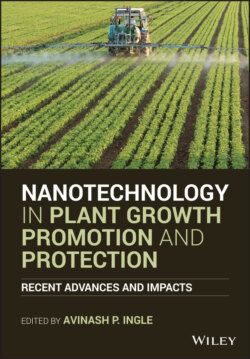Читать книгу Nanotechnology in Plant Growth Promotion and Protection - Группа авторов - Страница 21
1.2.5 Non‐nutrient Nanofertilizers
ОглавлениеThere are other nanoparticles which are not classified as plant nutrients but potentially have positive impact on plants. These nanoparticles mainly include CNTs, chitosan (Cs), cerium(IV) oxide (CeO2), silicon dioxide (SiO2), and titanium dioxide (TiO2). Although they are not of nutritional need to the plant, but they can improve growth and yield (Adisa et al. 2019). CNTs were found to increase shoot length of date palm (Phoenix dactylifera) at 0.05–0.1 mg/L (Taha et al. 2016) and promote growth of tobacco plants at 5–500 mg/L (Khodakovskaya et al. 2012). Studies have showed that Cs nanoparticles improve seed germination, enhance plant growth, increase photosynthesis, and improve crop yield (Adisa et al. 2019). Van et al. (2013) treated Robusta coffee plants with nanochitosan under greenhouse conditions which resulted in increased chlorophyll content and photosynthetic rate as well as increased nutrient accumulation as compared with untreated plants. Cu‐chitosan nanoparticles increased seedling growth, fresh, and dry mass of tomato plants as compared with untreated plants (Saharan et al. 2015). Pretreatment of maize seeds with Cu‐chitosan nanoparticles improved seed germination and growth parameters as compared with untreated control (Saharan et al. 2016).
In a similar manner, CeO2 nanoparticles reported to increase shoot biomass, growth, and grain yield of wheat plants relative to untreated plants (Rico et al. 2014). A similar finding was recorded for shoots of barley with CeO2 nanoparticles (Rico et al. 2015). Foliar application of SiO2 to cucumber (Cucumis sativus) resulted in increased plant height, biomass, growth and yield as compared with untreated control (Yassen et al. 2017). Application of SiO2 to strawberry (Fragaria × ananassa) increased macronutrients and micronutrients uptake (K, Ca, Mg, Fe, Mn, and Si) in plants as compared with untreated plants (Yousefi and Esna‐Ashari 2017). TiO2 nanoparticles have been tested on various crops such as spinach (Hong et al. 2005), lettuce (Zahra et al. 2015), tomato (Tiwari et al. 2017), Lemna minor (Song et al. 2012), watermelon (Wang et al. 2013), wheat (Feizi et al. 2012), and mung beans (Raliya et al. 2015). These studies conclude that TiO2 nanoparticles were able to increase plant growth and yield, increase chlorophyll content, enhance photosynthetic rate, and improve germination rate. But the plant responses depend on plant type, nanoscale properties, and concentrations and the method of application (Raliya et al. 2018).
